After Sporting Portugal suffered a 5-0 shellacking at Benfica’s hands in the Portuguese Super Cup, the club made a slew changes. In fact, this Sporting looks very little like that side.
Marcel Keizer was replaced just five games into the season, eventually leading to the hiring of Silas. Bas Dost now dons an Eintracht Frankfurt kit, promising Alcochete graduate Thierry Correia was sold to Valencia and Raphina earned a €20m move to Rennes. In their place, Sporting signed Yannick Bolasie and Jesé on loan.
For Benfica, the Portuguese Super Cup win was just the start of a brilliant first-half. Through 16 games, Bruno Lage’s side sits atop the Liga NOS table, four points ahead of Porto. With 15 league wins and just one defeat, the only real disappointment is the failure to qualify for the UEFA Champions League knockout stage despite a generous draw.
In this tactical analysis, we’ll preview the Derby de Lisboa. In this analysis, we’ll look at the tactics that will most influence the matchup, including Benfica’s build-up versus Sporting’s middle block, how Benfica will look to attack from the half-spaces and the tactical vulnerability that Sporting will look to attack.
Benfica’s build-up vs Sporting’s middle block
Benfica’s build-up
Benfica lead Portugal’s Liga NOS with 40 goals in just 16 games. That’s an average of 2.50 goals per game off an xG per 90 minutes of 1.82, so the Portuguese leaders are remarkably efficient in front of goal. That said, Benfica attacks in such a way that it limits the opposition’s chances, holding opponents at 0.38 goals per game, which is below the xGA 0.71 a match. Given the strength of its squad relative to the league, Benfica’s quality forces the opposition to play more conservatively, often dropping all or all but one player behind the ball.
In its typical 1-4-4-2, Benfica operates through short passes in an overloaded central part of the field. As the opposition overcommit to the middle, Benfica looks to play wide. Álex Grimaldo is the typical beneficiary of Benfica’s central dominance. The Spanish left-back has channelled his playmaking abilities into six assists. According to WhoScored, Grimaldo leads the team with 2.1 crosses per game and trails only Pizzi in the key passes category, contributing 2.3 per match.
Look for Benfica to possess centrally and along the backline to give Grimaldo time to start higher up the pitch. From there, watch Benfica’s forwards and two wide midfielders attack the Sporting with runs in behind the defence. Sporting will have to respect the runs, but also show an understanding that Benfica uses decoy runs to draw its opposition away from the middle, allowing Pizzi or one of the holding mids to attack open space and get the ball into the box.
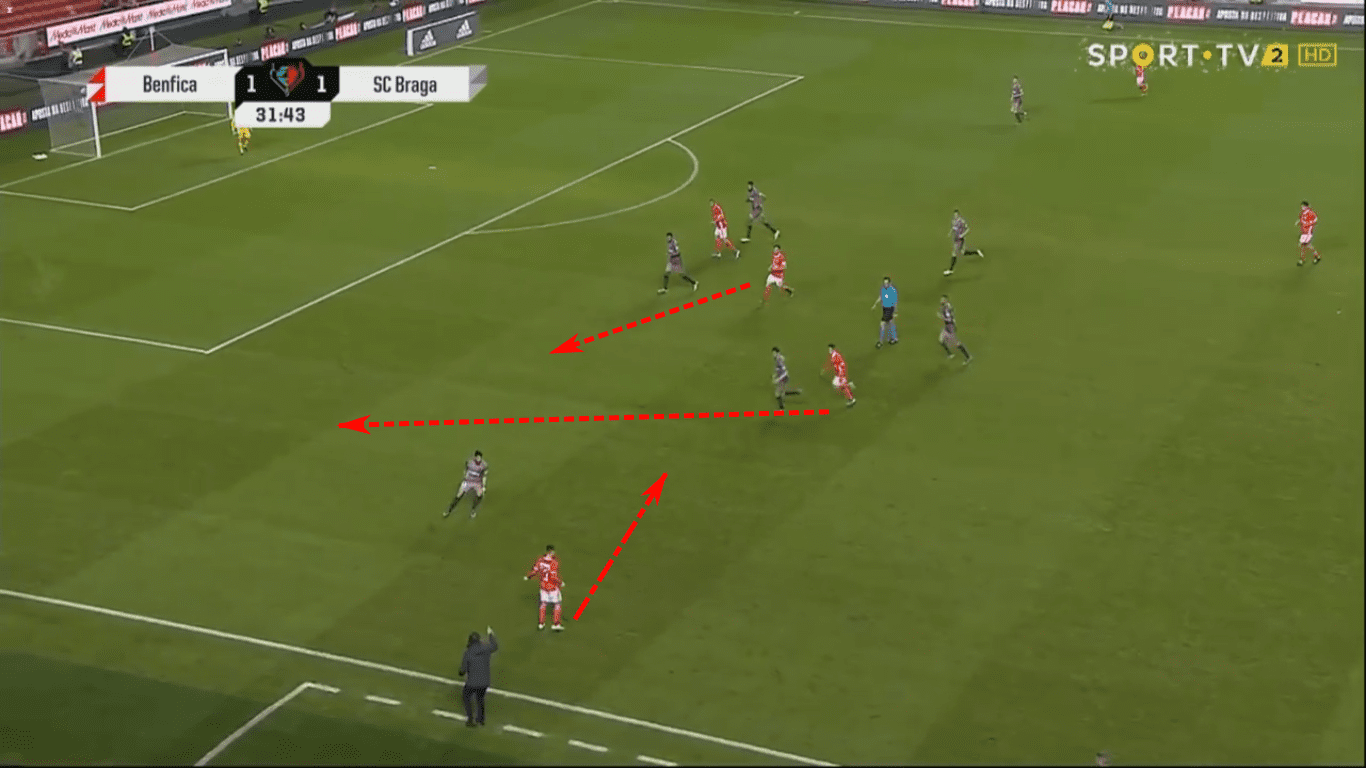
In this instance, Benfica has just completed a switch of play. You can see Grimaldo isolated on the left-wing with runners arriving in support. Deciding against the wide route, Grimaldo let his teammates continue their runs deep into the half-space and wing.
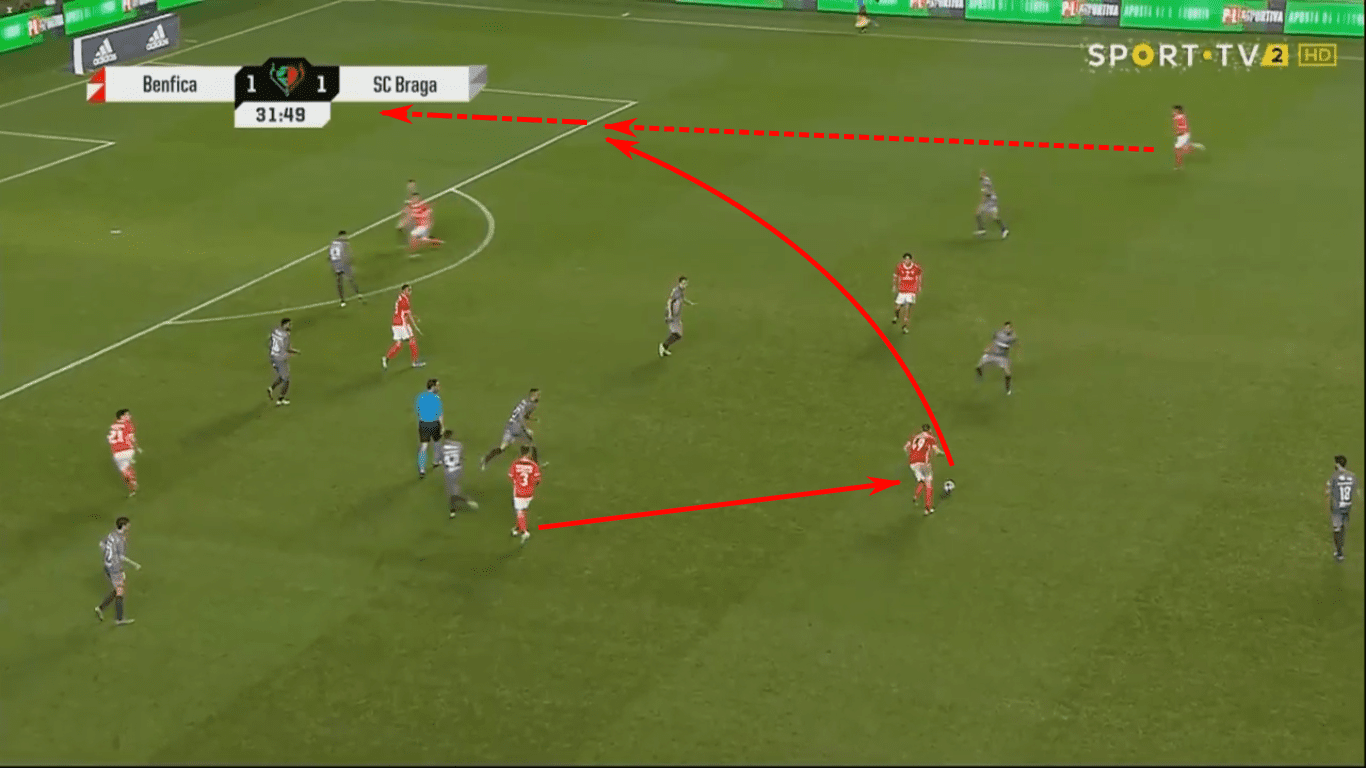
Once they vacated the deeper pocket in the half-space, Grimaldo dribbled inside. After commanding the attention of the Braga midfield, a simple layoff to Adel Taarabt saw the Braga lines in disarray. Young outside-back Tomas Tavares caught a glimpse of the available lane and initiated his sprint from deep. Taarabt bent a beautiful ball onto the run of Tavares.
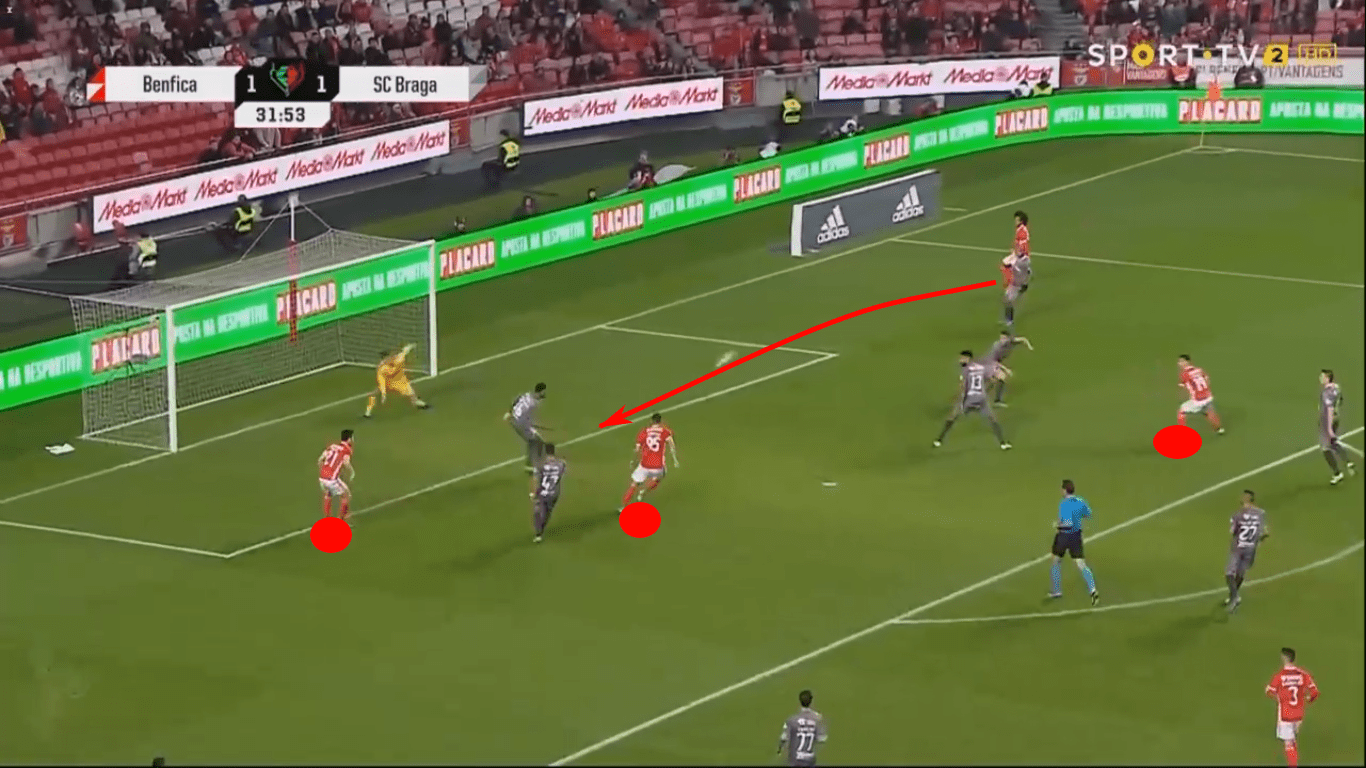
Tavares turned the corner on his mark and delivered a dangerous ball from the half-space, six metres from the endline. Vinicius, the Benfica forward, was a few steps behind the play, allow Braga to clear the cross.
Sporting’s middle block
As for Sporting, the middle block has worked well in recent weeks. The front four have done well to funnel play and limit the opposition to low percentage passing opportunities. In its past seven games, Sporting is conceding an average of nine shots per game with only 3.1 shots on goal per game. Sporting’s recent run of play has lowered it’s per-game averages to 10.13 shots against and 3.75 shots on target (37.04%). Many times, the front four force the opponent to play a hopeful long-ball, leading to Sporting’s decreases in interception and clearances per game.
Paired with the funnelling and pressure of the front four is the compact and connected shape of the backline and holding midfielders. Idrissa Doumbia and Wendel have added a layer of protection in front of the centre-backs that was lacking early in the season. Given Sebastián Coates and Jeremy Mathieu’s struggle to defend against the dribble, Doumbia and Wendel have done brilliantly to track and defend against attackers looking to play between the lines. This is the single most important tactical battle in today’s derby. Sporting can’t afford to let Benfica’s wide midfielders collect the ball between Sporting’s backline and holding mids.
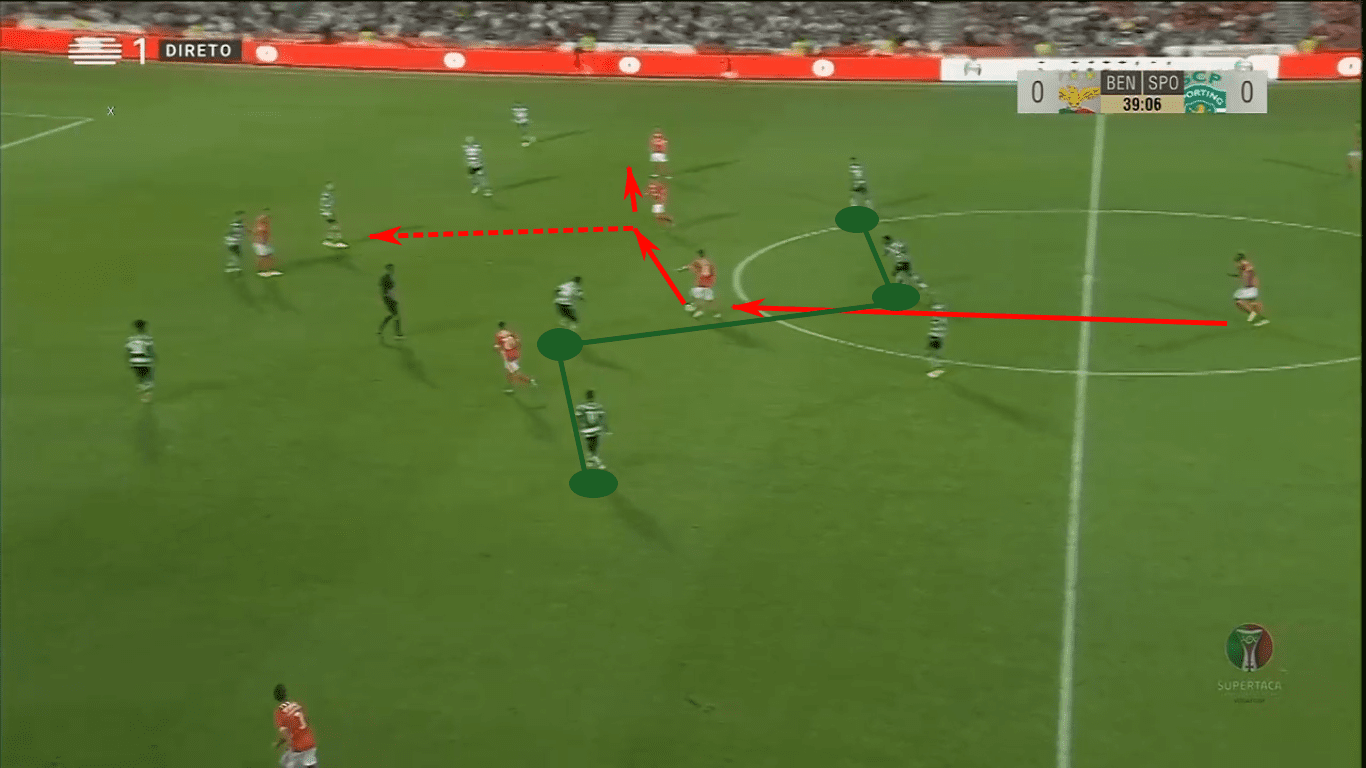
During the last Derby de Lisboa in August, the Sporting midfield was picked apart, leading to Benfica’s first goal. In the build-up to the goal, Wendel pushed far too high up the field, leaving his mark in the soft spot between him and Doumbia. The line breaking pass left Bruno Fernandes out of position despite a good initial angle to close the passing lane. While Keizer’s 1-5-4-1 didn’t help Sporting account for the numbers between the lines, you see five Sporting defenders accounting for one Benfica attacker. Realistically, Marcos Acuña should have pushed higher up the pitch to help take away the options in Benfica’s right-half space.
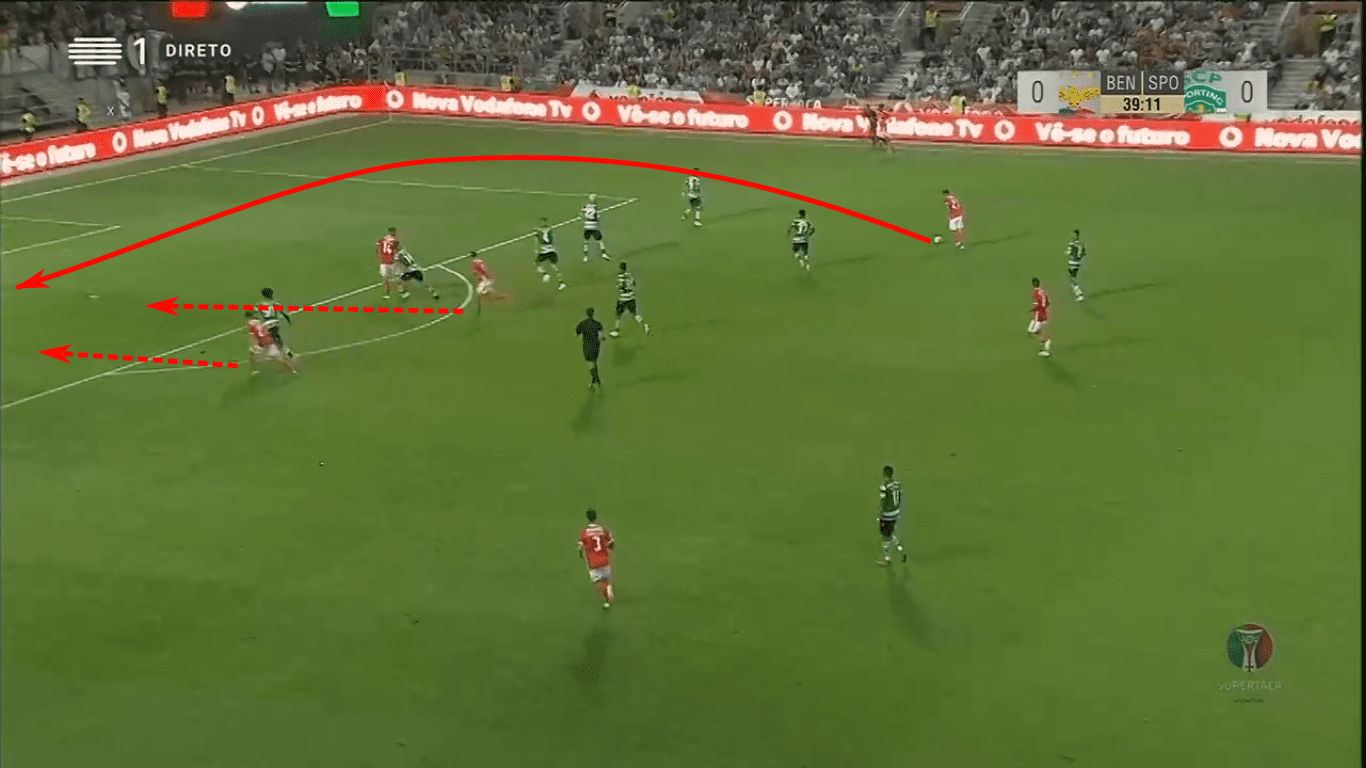
Even with five defenders, Sporting Portugal gave Benfica the time to receive the ball in the half-space and pick out a target. Benfica also has a 3v2 advantage at the back-post, as Coates and Doumbia failed to track the runners from deep. Thierry Correia was left 1v2 at the back-post and was unable to defend the cross, leading to Benfica’s opening goal. Though Sporting is more disciplined and better structured under Silas, defending crosses from the half-spaces and deep central runners is the priority in this match.
Benfica will attack from the half-spaces
In the previous section, we discussed Benfica’s build-up, moving the opposition centrally to play wide, then go back to the middle after a series of decoy runs. Progressing from that point, Benfica ranks third in Liga NOS with 24 crosses per game. However, it’s the location of the crosses that provides a clear snapshot of As Águias style of play.
Watch Benfica’s crosses closely and you’ll notice that the majority come either from the half-space or just beyond. Of Benfica’s 32 goals that occurred either in the run of play or after the first clearance of a set-piece, 14 goals come from low driven crosses from the half-space or first two metres of the wing. In fact, when Benfica has successful crosses from the wings, they’re typically early crosses. Expect Benfica to patiently create crossing opportunities from the half-spaces, disconnecting Sporting’s outside and centre-backs, then playing a split into a low cross.
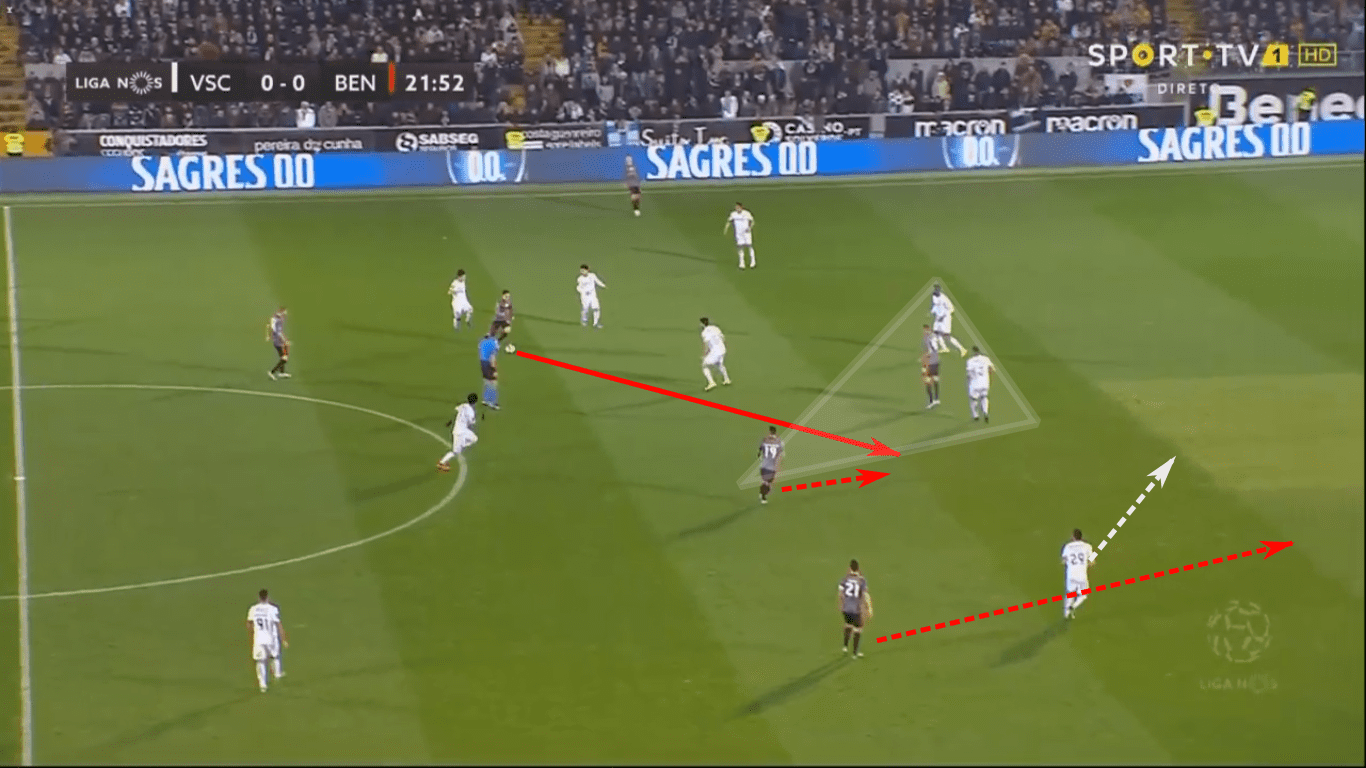
In its recent match against Vitória de Guimarães, Benfica showcased a common attacking approach that led to a goal. At the top of the image, you see Grimaldo, playing his standard high and wide role within Benfica’s tactics. Vinícius and Chiquinho were 2v2 with the centre-backs, forcing the Guimarães left-back, Florent Hanin, to move centrally in coverage. Franco Cervi played a pass to Chiquinho, who had room to penetrate via the dribble.
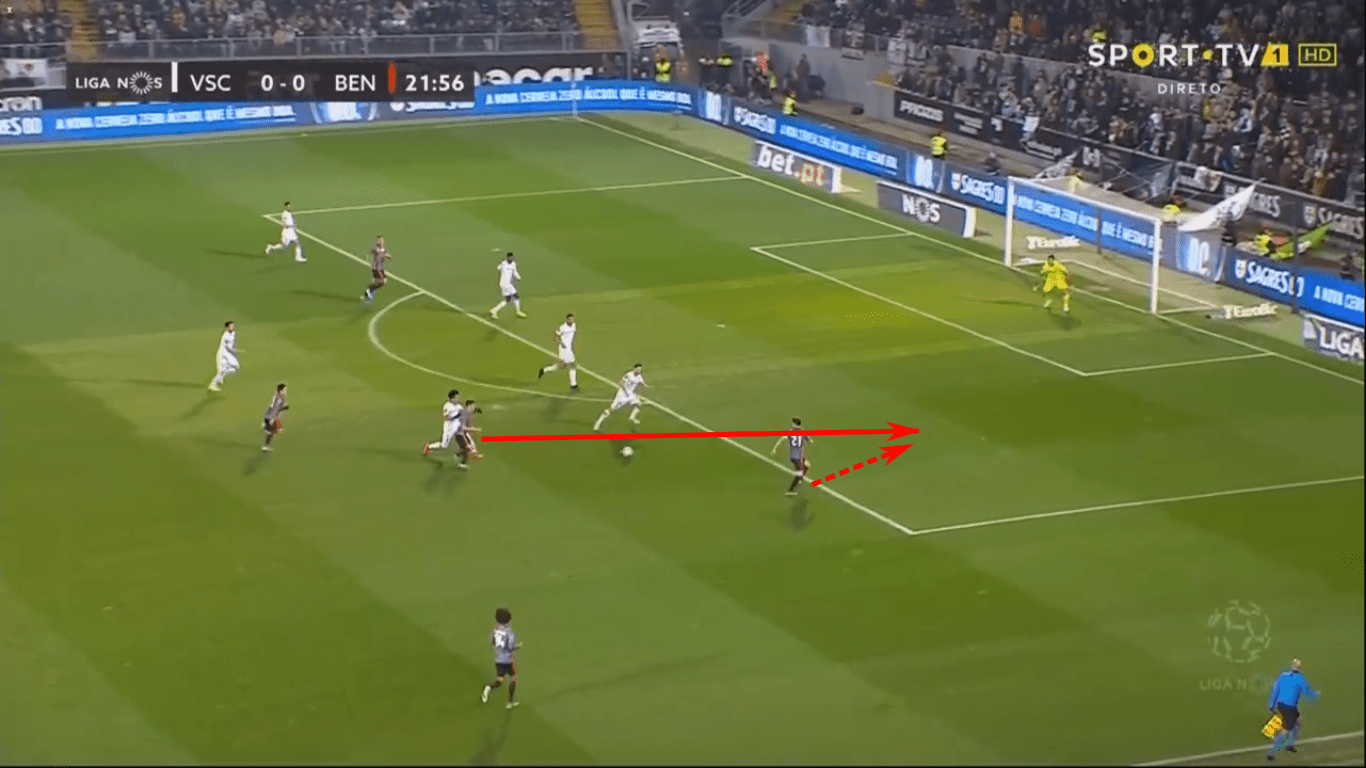
As Chiquinho dribbled down the field, the Guimarães backline moved centrally with a horizontally compact line. Pizzi read the play well, remaining in the right-half space, just waiting for Chiquinho to pin the defence. Once that happened, Chiquinho played his teammates in.
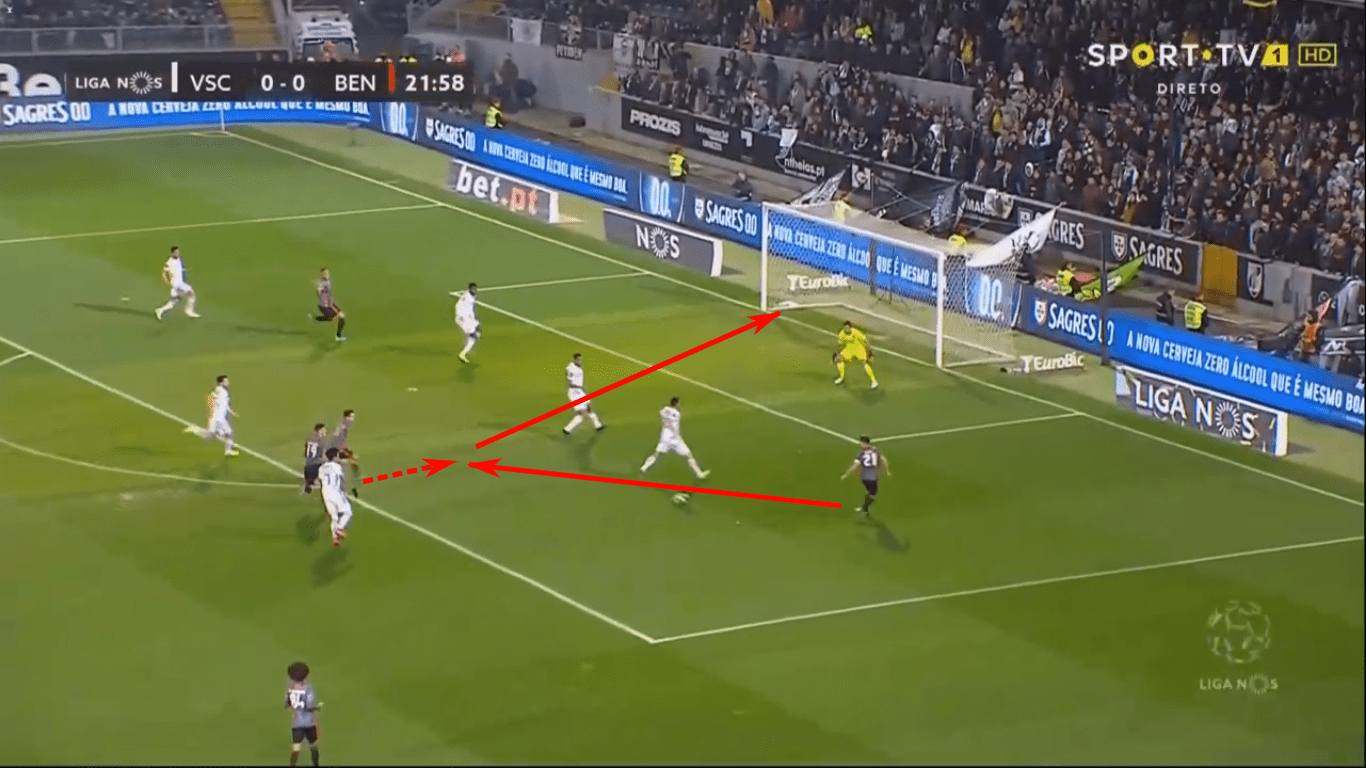
With the backline forced to scramble towards goal, they lost track of the runners, allowing Pizzi to play a negative cross onto the foot of Cervi. His finish was all Benfica needed to secure the three points. One point to note is that Benfica’s 4-4-2 is highly fluid in the midfield. While the four midfielders prefer to start in the central channel and half-spaces, they’re always looking to get between the lines and attack the soft spots of the defence. Benfica’s prolific goal-scoring form in Liga NOS is largely due to its opponent’s inability to cope with the central overload.
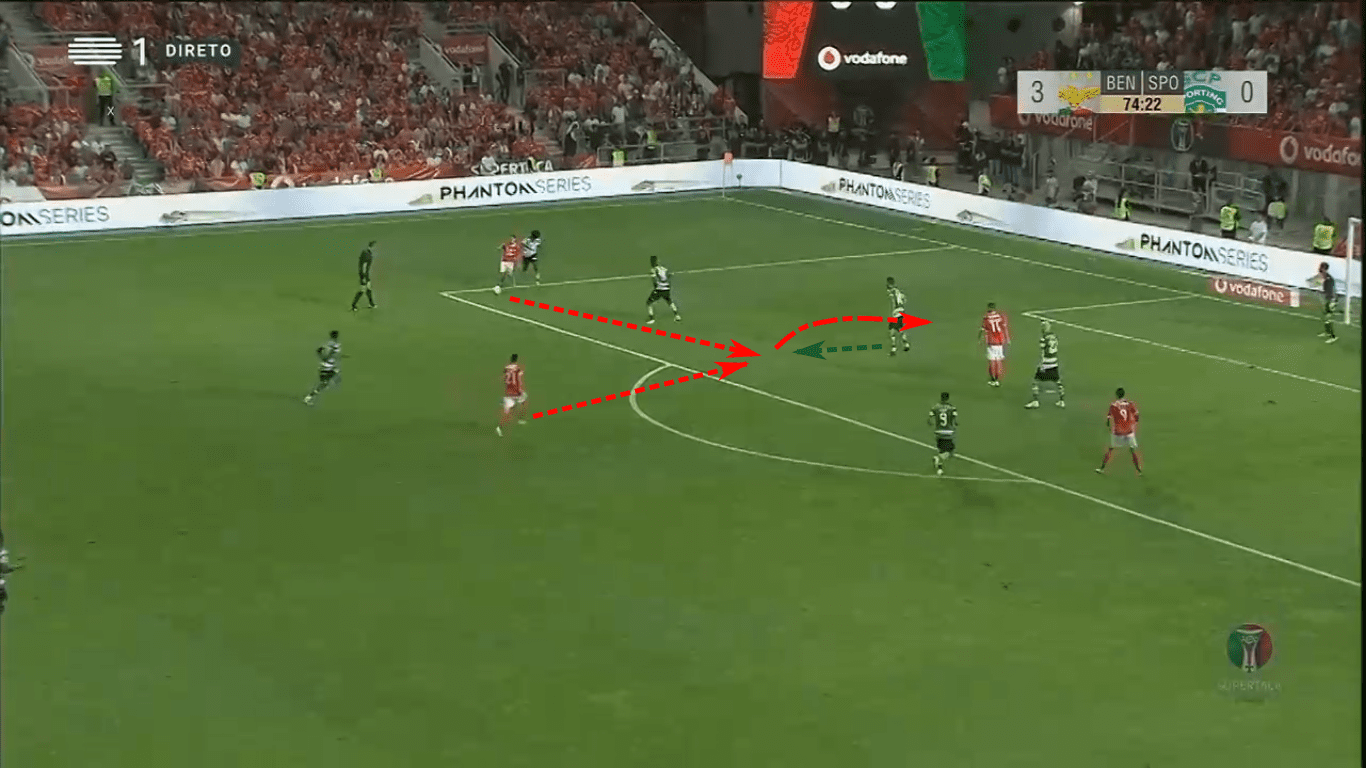
Sporting has fallen victim to Benfica’s chance creation and runs from deep too. Referring again to the Portuguese Super Cup, Pizzi’s late run from deep was untracked by the midfield, allowing him to take a fantastic touch around Coates and claim the fourth Benfica goal.
Sporting will attack behind Benfica’s outside-backs
Though Sporting is in the midst of a run of tough opponents, it benefits from playing Porto prior to the Derby de Lisboa. In the match against Porto, we saw Alex Telles serve as a wide playmaker. He routinely pushed high up the field in the wing to create a 1v1 with his opponent, pinning the defender while teammates made runs behind the Sporting backline. Despite the 2-1 loss, Os Leões played well, recording a 1.32 xG to Porto’s 0.69.
Since Benfica employs a similar tactical system, expect Sporting to use comparable tactics. Look for Yannick Bolasie to start a deeper in the midfield with the left attacking mid operating as a second forward and Fernandes given the freedom to attack the space vacated by Grimaldo. Whether in transition or open possessions, Bolasie’s deeper starting point will serve as bait for Grimaldo. If the left-back pushes high up the field to contest Bolasie, Fernandes will look to receive in the right-wing or half-space. Receiving in that area will draw Ferro out of the middle, allowing Luiz Phellype and Luciano Vietto’s left-attacking mid replacement to contest crosses in a 2v2 scenario.
If Benfica is able to get numbers behind the ball and set up a low or middle block, a common tactical approach from Sporting is to push the three attacking midfielders into the central channel and half-spaces while pushing the outside-backs higher up the field. The centre-backs and two holding midfielders will safely combine, looking for the opportunity to play the long diagonal to the outside-backs. As Benfica’s outside-backs move wide to pressure, you’ll see Sporting’s attacking midfielders making runs behind the line then delivering a low, driven cross into the box. A typical big-bodied poacher, Phellype will look to use his imposing size to score. His six goals on 3.28 xG show he’s a dangerous finisher, even when shooting from less desirable areas.
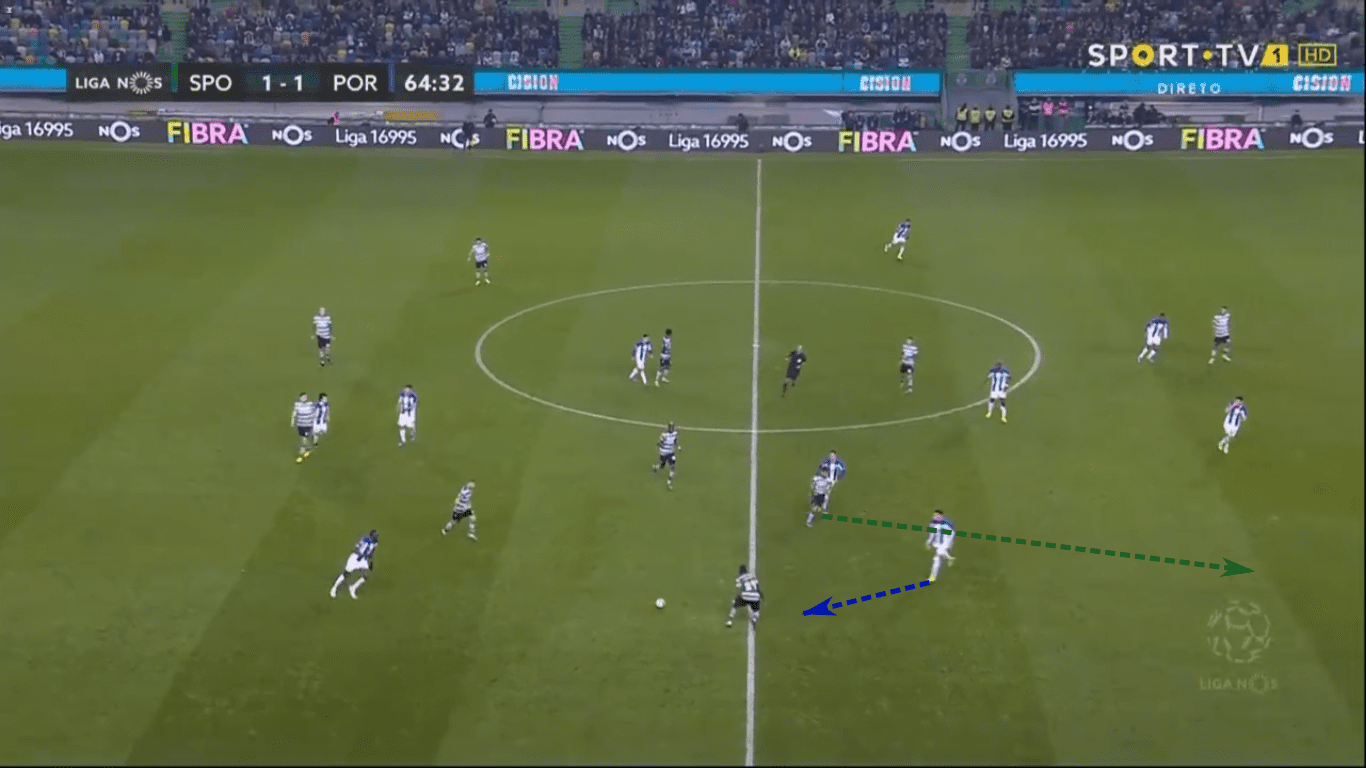
Against Porto, Bolasie positioned himself a little deeper than normal to account for the threat of Telles. In addition to the defensive benefit, Bolasie’s positioning created an attacking outlet for Sporting. As you see here, Telles had to move forward to meet Stefan Ristovski’s pass to Bolasie. Telles’ movement forward cued Fernandes to make his run in behind the defence. He’s a willing runner with great endurance, so this particular run was made throughout the game.
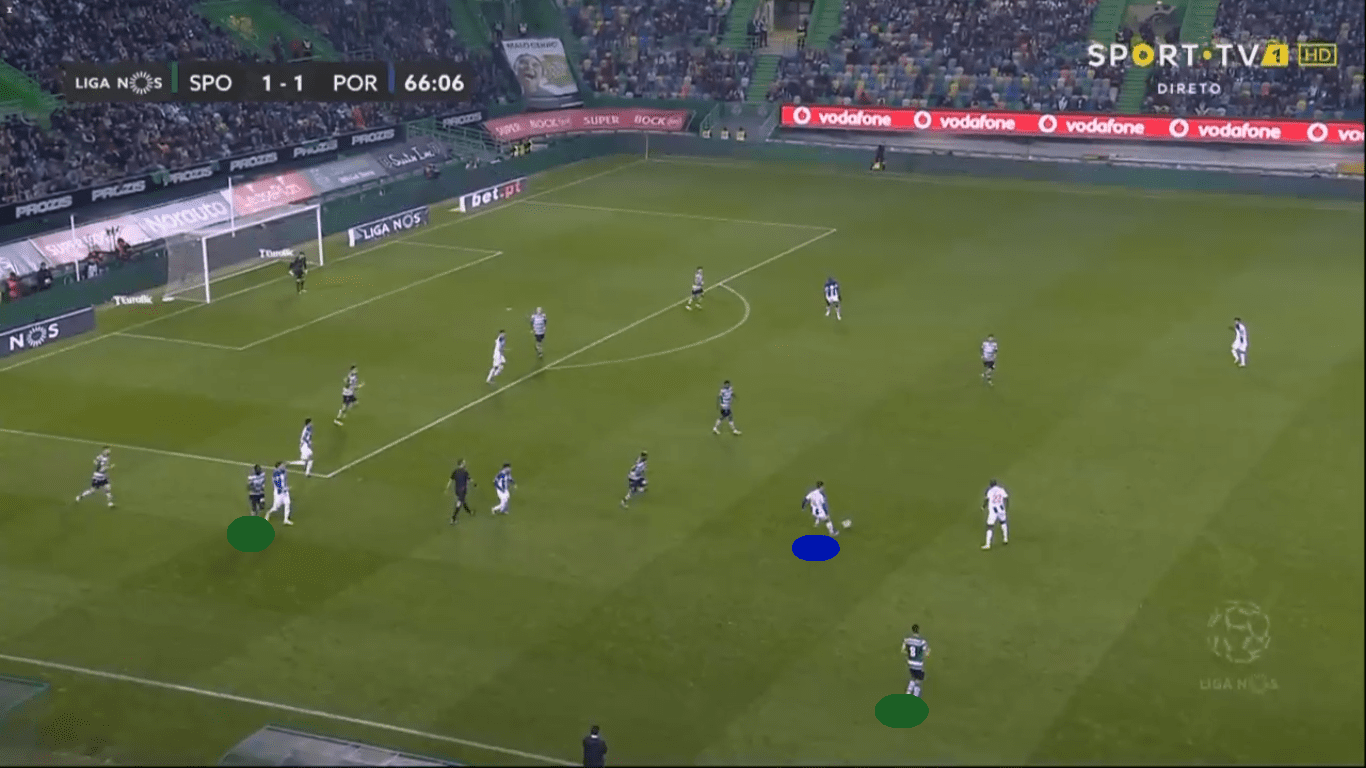
As Sporting defends Benfica’s attacking transitions, look for Fernandes to move to the right-wing if Bolasie is back to support the midfield or track the run of Grimaldo. If Sporting is able to recover the ball out wide or before Benfica establishes a positional attack, expect an early ball to Fernandes on the right-wing.
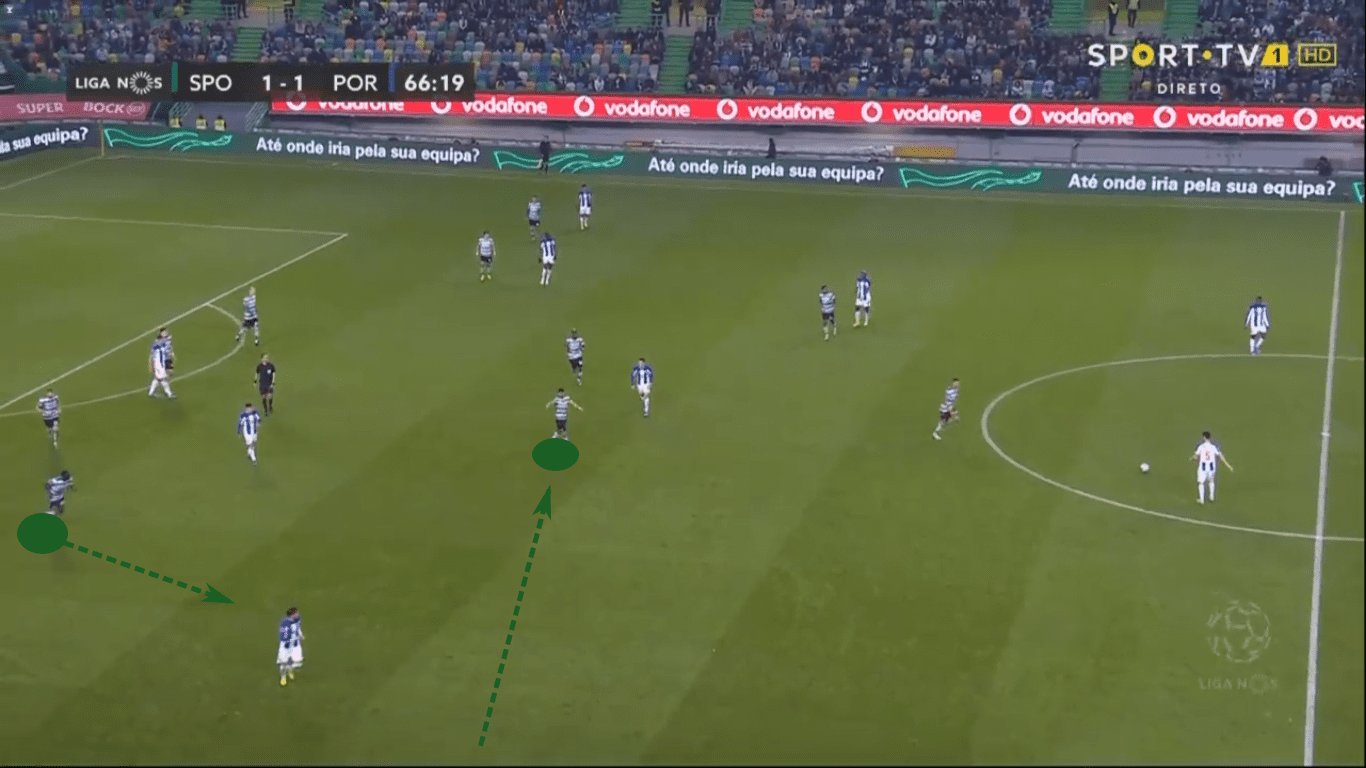
If, as in this instance, a positional attack develops, watch Bolasie remain deep long enough to allow Fernandes to recover to the middle while simultaneously denying a long pass to Grimaldo.
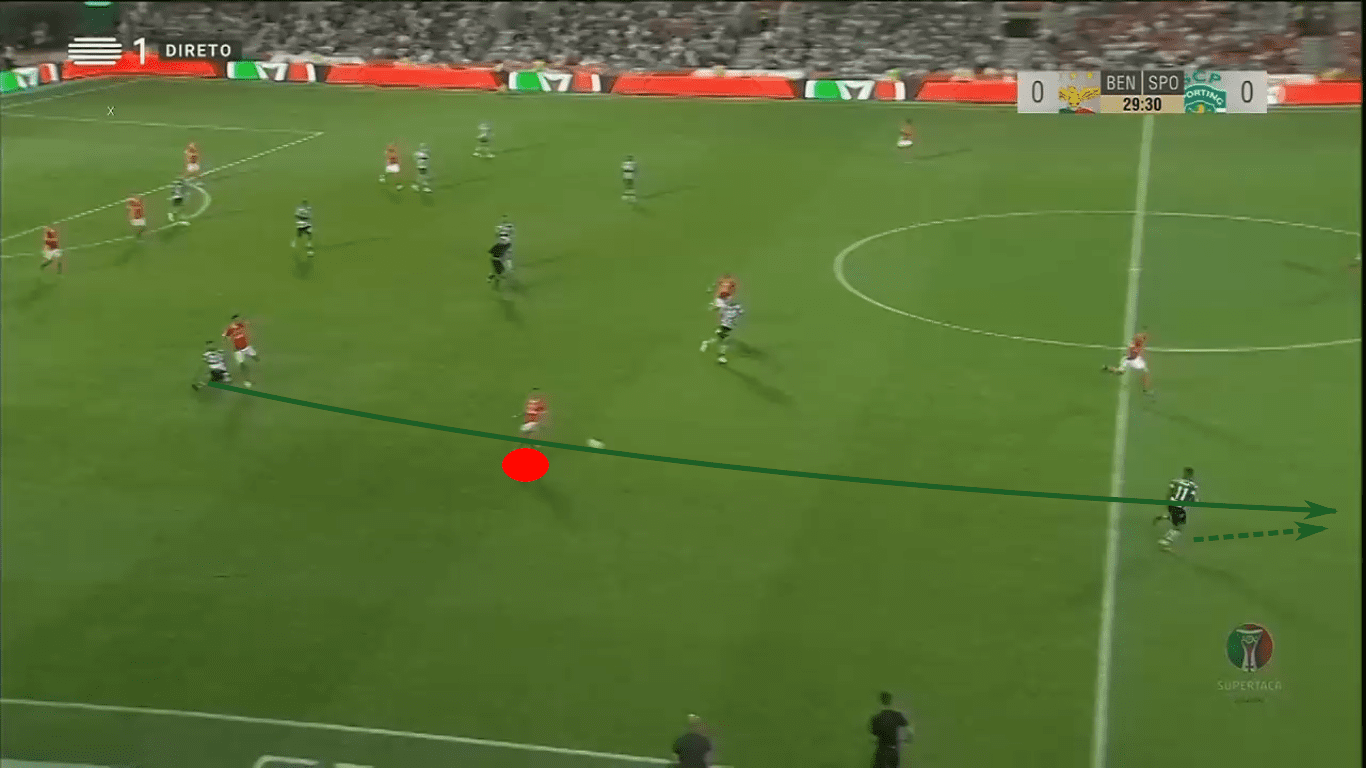
When Sporting recovers the ball after a Benfica positional attack, look for Bolasie to make his move up the wing, especially if Grimaldo is out of position, high up the pitch. While the scenario above shows Raphinha making the run, Bolasie will use his pace and strength in a similar manner.
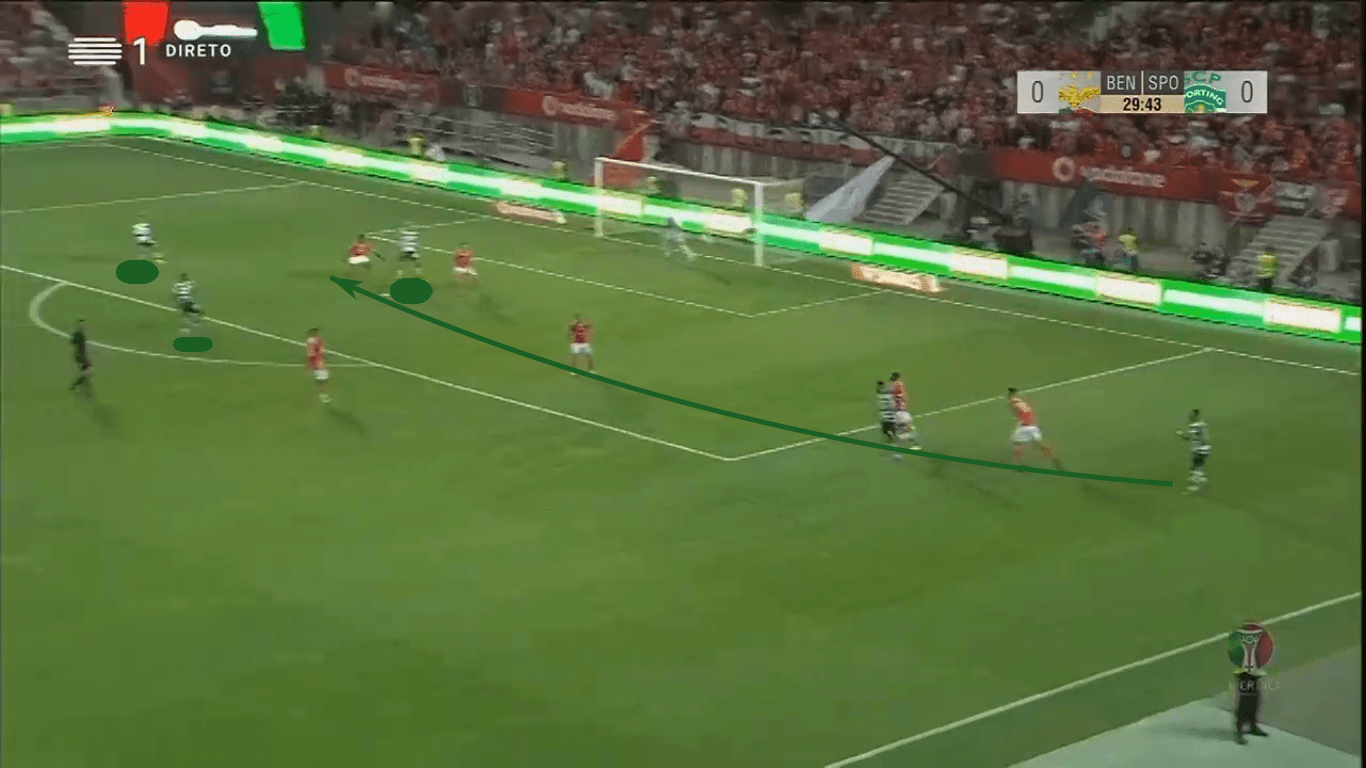
As Bolasie makes his run up the wing, watch Sporting’s attackers invade the middle of the box. Losing Vietto hurts, but expect Acuña to start and operate in a similar tactical role, playing just beneath the striker and offset to the left-half space. Expect the majority of Sporting’s crosses to come from Bolasie, Fernandes and Ristovski on the right.
Projected Lineups
Sporting Portugal 4-2-3-1: Luis Maximiano; Ristovski, Neto, Mathieu, Cristian Borja; Doumbia, Wendel, Fernandes; Bolasie, Phellype, Acuña
With Coates suspended for yellow card accumulation, Neto’s return from a broken rib is well-timed. His lack of match fitness could be an issue, one that could thrust Thiago Illori into the starting XI. When healthy, Neto is the better option of the two, but his lack of fitness is a major stumbling-block. In the midfield, Rodrigo Battaglia has returned from a knee injury, but expect the budding partnership of Doumbia and Wendel to win out. Up top, Acuña could drop to left-back, opening the door for Jesé or Raphael Camacho to start, but playing Borja and Acuña gives Sporting greater defensive stability without a drop in attacking threat.
Benfica 4-4-2: Odisseas Vlachodimos; André Almeida, Rúben Dias, Ferro, Grimaldo; Pizzi, Gabriel Pires, Taarabt, Cervi; Chiquinho, Haris Seferovic
The backline is pretty well set. Taveras could start in place of Almeida, but the youngster played just three days ago, giving Almeida plenty of rest for the derby. You’ve probably noticed the absence of recent transfer arrival Julian Weigl from the starting lineup. Though you can expect him to run the Benfica midfield in the near future, this is too big a game to test his chemistry with Gabriel. Expect him to sub on if Benfica is defending a lead. Rafa Silva should see the field too. Finally, up top, Vinicius and Jota have earned significant playing time of late, but expect Lage to lean on experience and the hot-hand of Seferovic.
Conclusion
From a tactical standpoint, expect this one to play out like Sporting’s recent game against Porto. Porto and Benfica both play a 4-4-2 with an electric left-back. A Benfica win will give Lage the most consecutive away wins in Portuguese history, as well as the highest point total after 17 rounds. For Sporting, it’s an opportunity to, at least temporarily, jump ahead of the Cinderella story in Liga NOS, Famalicão.
Don’t expect another demolition job. Silas has his Sporting side on the upswing, which was clear to see in the game against Porto. That said, the loss of Coates and Vietto is a massive blow. Unless you’ve taken residence under a rock, you’ve surely heard the Fernandes to Manchester United transfer rumours. Fernandes will surely view this as his last game for Os Verde e Brancos, which could provide the spark Sporting needs. Though a 1-1 draw wouldn’t shock me, 2-1 in favour of Benfica seems the more likely result.




Comments